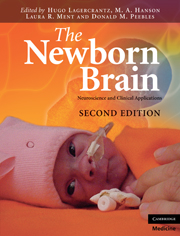Book contents
- Frontmatter
- Contents
- List of contributors
- Preface to the First Edition
- Preface to the Second Edition
- 1 Reflections on the origins of the human brain
- Section 1 Making of the brain
- 2 The molecular basis of central nervous system development
- 3 Holoprosencephaly and microcephaly vera: perturbations of proliferation
- 4 Neuronal migration
- 5 The neonatal synaptic big bang
- 6 Neurotrophic factors in brain development
- 7 Neurotransmitters and neuromodulators
- 8 Glial cell biology
- Section 2 Sensory systems and behavior
- Section 3 Radiological and neurophysiological investigations
- Section 4 Clinical aspects
- Section 5 Follow-up
- Section 6 Consciousness
- Index
- Plate section
- References
4 - Neuronal migration
from Section 1 - Making of the brain
Published online by Cambridge University Press: 01 March 2011
- Frontmatter
- Contents
- List of contributors
- Preface to the First Edition
- Preface to the Second Edition
- 1 Reflections on the origins of the human brain
- Section 1 Making of the brain
- 2 The molecular basis of central nervous system development
- 3 Holoprosencephaly and microcephaly vera: perturbations of proliferation
- 4 Neuronal migration
- 5 The neonatal synaptic big bang
- 6 Neurotrophic factors in brain development
- 7 Neurotransmitters and neuromodulators
- 8 Glial cell biology
- Section 2 Sensory systems and behavior
- Section 3 Radiological and neurophysiological investigations
- Section 4 Clinical aspects
- Section 5 Follow-up
- Section 6 Consciousness
- Index
- Plate section
- References
Summary
Introduction
During brain development, neocortical neurons derive from the primitive neuroepithelium and migrate to their appropriate position in the cerebral mantle, including the cortical plate (or prospective neocortex). In humans, neurons destined to the neocortex migrate mainly between the twelfth and the twenty-fourth week of gestation. In rodents, this developmental period/ontogenic step occurs roughly between embryonic day 12 (the gestation period is about 20 days in these species) and the first postnatal days. The first postmitotic neurons migrate to form a subpial pre-plate or primitive plexiform zone (for a review, see Marin-Padilla,1998) (Fig. 4.1, p. 56). Subsequently produced neurons, which will form the cortical plate, migrate into the pre-plate and divide it into the superficial molecular layer (synonym layer I, marginal zone containing Cajal-Retzius neurons) and the deep subplate (synonym cortical layer VIb). Schematically, successive waves of migratory neurons pass the subplate neurons and end their migratory pathway below layer I. These migrating neurons form successively the cortical layers VIa, V, IV, II, and II, following the inside-out pattern of cortical ontogenesis discovered by the pioneering autoradiographic study of Angevine and Sidman (1961).
Migration pathways and radial glia
A central hypothesis of current developmental neurobiology (for a review, see Rakic,1988) is that migrating neurons find their way from the germinative zone to the cortical plate by climbing along the radially ascending processes of specialized radial glial cells, a finding reported by Rakic (1971).
- Type
- Chapter
- Information
- The Newborn BrainNeuroscience and Clinical Applications, pp. 55 - 70Publisher: Cambridge University PressPrint publication year: 2010



